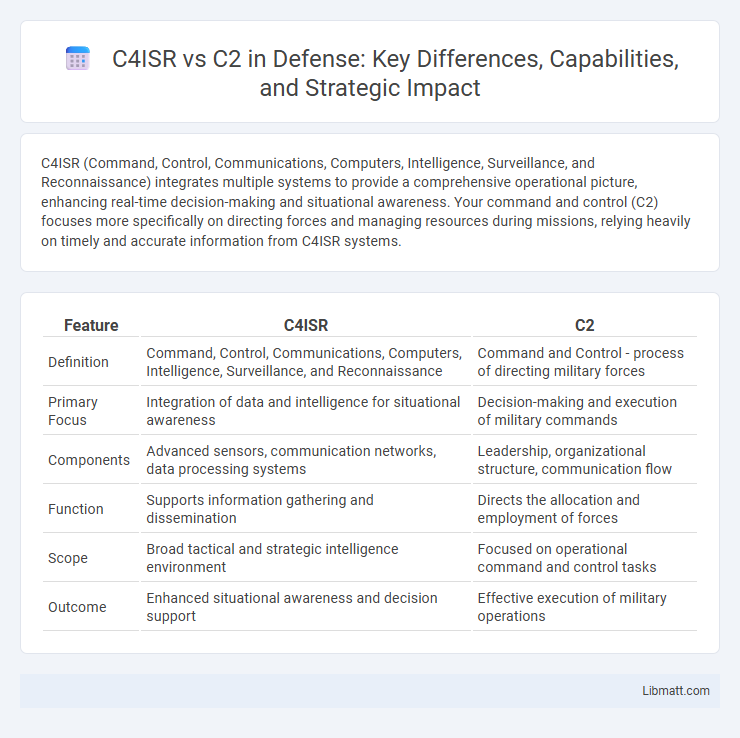C4ISR (Command, Control, Communications, Computers, Intelligence, Surveillance, and Reconnaissance) integrates multiple systems to provide a comprehensive operational picture, enhancing real-time decision-making and situational awareness. Your command and control (C2) focuses more specifically on directing forces and managing resources during missions, relying heavily on timely and accurate information from C4ISR systems.
Table of Comparison
| Feature | C4ISR | C2 |
|---|---|---|
| Definition | Command, Control, Communications, Computers, Intelligence, Surveillance, and Reconnaissance | Command and Control - process of directing military forces |
| Primary Focus | Integration of data and intelligence for situational awareness | Decision-making and execution of military commands |
| Components | Advanced sensors, communication networks, data processing systems | Leadership, organizational structure, communication flow |
| Function | Supports information gathering and dissemination | Directs the allocation and employment of forces |
| Scope | Broad tactical and strategic intelligence environment | Focused on operational command and control tasks |
| Outcome | Enhanced situational awareness and decision support | Effective execution of military operations |
Introduction to C4ISR and C2 Systems
C4ISR (Command, Control, Communications, Computers, Intelligence, Surveillance, and Reconnaissance) integrates multiple technologies and processes to provide comprehensive battlefield awareness and decision-making capabilities. C2 (Command and Control) systems focus primarily on the execution of command decisions and the management of forces in real-time operational contexts. Your understanding of these systems highlights how C4ISR enhances C2 by offering advanced data collection and intelligence support to optimize military command effectiveness.
Defining C4ISR: Components and Functions
C4ISR stands for Command, Control, Communications, Computers, Intelligence, Surveillance, and Reconnaissance, encompassing critical components that enable comprehensive battlefield awareness and decision-making capabilities. Its functions integrate advanced communication networks, data processing systems, and intelligence gathering to support real-time command and control operations. You leverage C4ISR to enhance situational understanding and streamline coordination across military units, differentiating it from the more limited scope of traditional C2 systems.
Understanding C2: Core Principles Explained
Command and Control (C2) is a fundamental military concept involving the exercise of authority and direction over assigned forces to accomplish missions effectively. Core principles of C2 include unity of command, centralized planning with decentralized execution, and clear communication channels to ensure timely decision-making and situational awareness. C4ISR (Command, Control, Communications, Computers, Intelligence, Surveillance, and Reconnaissance) supports C2 by integrating technology and information systems that enhance real-time operational control and intelligence sharing.
Historical Evolution: C4ISR and C2 Development
C4ISR (Command, Control, Communications, Computers, Intelligence, Surveillance, and Reconnaissance) evolved from traditional C2 (Command and Control) systems by integrating advanced technologies to enhance situational awareness and decision-making capabilities. The historical evolution of C4ISR reflects a shift from basic command structures toward network-centric warfare, emphasizing real-time data sharing and intelligence fusion. This development has improved operational efficiency by connecting multiple platforms and improving coordination across military operations.
Key Differences Between C4ISR and C2
C4ISR (Command, Control, Communications, Computers, Intelligence, Surveillance, and Reconnaissance) integrates diverse military systems to provide comprehensive situational awareness and decision-making support, while C2 (Command and Control) primarily focuses on the exercise of authority and direction over assigned forces. C4ISR encompasses advanced data collection, analysis, and dissemination technologies, enhancing real-time battlefield information flow, whereas C2 is centered on command execution, strategic planning, and operational coordination. The key difference lies in C4ISR's role as an enabling framework for information superiority that supports C2's decision-making and command functions.
Overlapping Roles in Military Operations
C4ISR (Command, Control, Communications, Computers, Intelligence, Surveillance, and Reconnaissance) and C2 (Command and Control) share overlapping roles in military operations by enabling decision-making processes through real-time data collection and communication systems. Both frameworks support situational awareness, operational planning, and the coordination of forces, but C4ISR integrates a broader range of intelligence and technological assets to enhance battlefield visibility and responsiveness. Understanding how Your operational command benefits from the synergy between C2's leadership functions and C4ISR's comprehensive information management is crucial for mission success.
Technology Integration in C4ISR vs C2
C4ISR integrates advanced technologies such as sensors, satellites, communication networks, and data analytics to provide a comprehensive operational picture, enhancing real-time situational awareness and decision-making. C2 primarily focuses on communication and command systems that coordinate forces and execute orders but relies on C4ISR systems for detailed intelligence and surveillance inputs. The technological fusion in C4ISR enables seamless interoperability across multiple domains, whereas C2 technology is centered on command execution and management within the operational framework.
Advantages and Limitations of Each System
C4ISR systems offer enhanced situational awareness by integrating Command, Control, Communications, Computers, Intelligence, Surveillance, and Reconnaissance, enabling real-time data fusion and decision-making across multiple domains. However, their complexity and high dependency on advanced technology can lead to vulnerabilities in cyber warfare and require significant investment and maintenance. In contrast, C2 systems focus on command and control functions with simplicity and directness, offering quicker decision cycles in smaller-scale operations but lacking the comprehensive intelligence integration and scalability of C4ISR.
Real-World Applications: Case Studies
C4ISR systems integrate command, control, communications, computers, intelligence, surveillance, and reconnaissance to provide comprehensive situational awareness and decision-making capabilities in complex military operations. In real-world applications, C4ISR proved crucial during operations like Operation Desert Storm, where integrated intelligence and surveillance significantly enhanced coalition forces' precision targeting and battlefield coordination. Your deployment of C2 systems without the extended intelligence and reconnaissance capabilities of C4ISR may limit situational awareness and reduce operational effectiveness in dynamic combat environments.
Future Trends: The Convergence of C4ISR and C2
The future of military operations hinges on the convergence of C4ISR (Command, Control, Communications, Computers, Intelligence, Surveillance, and Reconnaissance) and C2 (Command and Control) systems, enhancing decision-making speed and battlefield awareness. Emerging technologies like artificial intelligence, machine learning, and advanced sensor integration will enable seamless data fusion, providing commanders with real-time, actionable intelligence. Your strategic advantage increases as these integrated systems support adaptive, network-centric warfare, ensuring precise command execution and superior situational dominance.
C4ISR vs C2 Infographic

 libmatt.com
libmatt.com